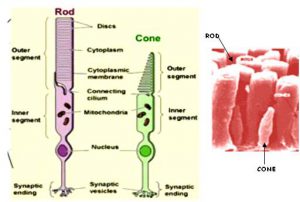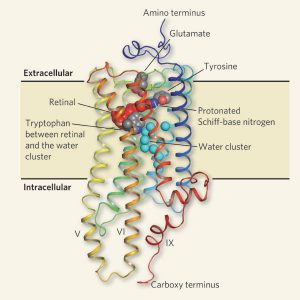
Humans are able to sense light due a thick layer of light sensitive cells, rods and cones, present in the retina in the back of our eyes. Cone cells are concentrated in the center of our eye and allow us to see color and fine details. However, these cones require strong light in order to function therefore do not do well in low light settings. Meanwhile, our rod cells are much more sensitive and operate in low/dim light. These rods are spread all throughout the retina and the edge of our eyes. They help with our peripheral vision and allow us to see black, white, and shades of gray. One important factor found present in rod cells is rhodopsin, a light-sensitive receptor protein that is key to our night vision. Franz Christian Boll, a German physiologist, first discovered rhodopsin in 1876. In Greek, rhodon means “rose” while opsis means “sight.” Boll named this protein Rhodopsin due to its purplish coloration.

Rod and cone cells in the eye. Blueconemonochromacy.org/how-the-eye-functions
Rhodopsin is what allows the rods in our eyes to absorb photons and perceive light, making it essential to our vision in dim light. As rhodopsin absorbs a photon, it splits into a retinal and opsin molecule and slowly recombines back to into rhodopsin at a fixed rate. However, this is a gradual process, which is why it takes a while for our eyes to adjust in the dark. For humans, it takes about 45 minutes for our eyes to adjust to the dark.
This is why it is important to stay away from bright lights once you have developed your night vision because this protein is extremely sensitive to bright lights. Once rhodopsin is exposed to bright light, it immediately photobleaches and breaks down – the rhodopsin splits back into retinal and opsin molecules. As a result, the rhodopsin that took so long to build up is no longer present in our eyes, and we are essentially blind in the darkness until that rhodopsin recombines back to its state.

Squid rhodopsin. Murakami and Kouyama, The Rhodopsin Story Continued. Nature 453, 292-293 (15 May 2008)
But over the years we have figured out ways to create light that is not so detrimental to our night vision. For example many lights now have a red light feature. Rhodopsin is not as sensitive to red light due to its long wavelengths – red light depletes the stored rhodopsin at a very slow rate. As a result we are able to preserve our night vision with red light rather than destroy it.

Red headlamp for preserving night vision. Juligo, campstuffs.com
Written By: Alex Feltes
Sources:
http://phenomena.nationalgeographic.com/2014/03/13/how-light-wakes-up-the-brain/
https://www.britannica.com/science/rhodopsin
http://www.chm.bris.ac.uk/webprojects2003/rogers/998/Rhoeye.htm


